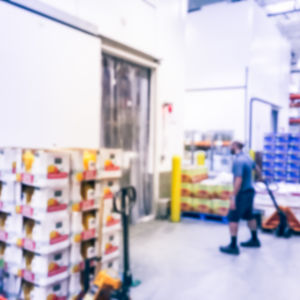Estimated reading time: 3 minutes
Though we often take it for granted, meals are the one time when family can all come together and be together for a period of time. Whether it’s a holiday celebration or just another Tuesday night dinner, that food came from somewhere, maybe local or perhaps even from a distant, far-off country. Regardless of its origin point, it’s safe to say it traveled quite some time to get to its resting point on the dinner table.  On this long journey, it’s important to clarify each of its stopping points, and if anything were to happen during the trip that were to compromise the package in any way. Could you imagine not being informed if a pallet or salmon were unwrapped or not cooled correctly and then buying a cut of the fish at the grocery store? Talk about a mistake. Food vendors and distributors work very closely to avoid issues like this from ever taking place through the process of securing the supply chain with tracking and tracing capabilities.
On this long journey, it’s important to clarify each of its stopping points, and if anything were to happen during the trip that were to compromise the package in any way. Could you imagine not being informed if a pallet or salmon were unwrapped or not cooled correctly and then buying a cut of the fish at the grocery store? Talk about a mistake. Food vendors and distributors work very closely to avoid issues like this from ever taking place through the process of securing the supply chain with tracking and tracing capabilities.
Enhancing traceability in the food supply chain is one known preventative measure and its wider implementation could help check the spread of food-borne illnesses everywhere. According to the Centers for the Disease Control (CDC), the US happens to be struggling to contain the spread of food-borne pathogens. Norovirus, Salmonella, Clostridium Pefringens, and Staphylococcus aureus are just a few of the most common germs spread during the neglected care of food as it makes its way through the supply chain to us, the consumer. The US Federal Government estimates at least 48 million cases of food-borne illnesses are recorded each year. Properly equipped supply chains can utilize food traceability to better track food-borne illnesses back to their origination and likely intercept actively contaminated food items within the supply chain, before they ever leave the chopping block.
Read more from VARTECH Nation: Acquiring Food Supply Chain Visibility
The ability to track an illness back to its source, find any food that may have been potentially spoiled and contaminated, and then to swiftly remove any amount of the infected product from a store’s shelves or a restaurant’s inventory can help to save more lives every day.  There are various requirements that have been put into place, specifically by the Public Health Security and Bioterrorism Response Act of 2002, which inspired the U.S. Food and Drug Administration (FDA) to demand that food producers, transporters, and retailers are able to provide one-step back and one-step forward traceability a more recognized practice to be expected going forward.
There are various requirements that have been put into place, specifically by the Public Health Security and Bioterrorism Response Act of 2002, which inspired the U.S. Food and Drug Administration (FDA) to demand that food producers, transporters, and retailers are able to provide one-step back and one-step forward traceability a more recognized practice to be expected going forward.
When it comes to improving traceability, RIFD chips and Barcodes are some of the best-known technology utilized throughout this process to help provide the most spot-on accuracy. SKUs and RFID chips allow an insight view into the supply chain and that sense of greater connectivity allows for vendors and retailers to have access to such data, seeing as though it is trackable and lives within a centralized database. RFID chips can be used within warehousing facilities to be attached to pallets,  simplifying the inventory processes. RFID doesn’t require line-of-sight scanning, so this way no heavy duty lifting has to be done to complete a task while on the clock. Pallets can stay in place and logging tasks can be automated instead.
simplifying the inventory processes. RFID doesn’t require line-of-sight scanning, so this way no heavy duty lifting has to be done to complete a task while on the clock. Pallets can stay in place and logging tasks can be automated instead.
Introducing a completely different method, blockchain-powered traceability platforms can help provide levels of trust with purchasing fresh food, especially within regions who have been hit by massive food-borne illnesses before. This upgrade can help vendors and grocery stores to track the location of their parcels throughout every step of their journey, so that way if anything were to go wrong, they can keep in the know, the entire time. Track and trace platforms, in general, have gained a newfound importance with the surge of COVID-19 cases amongst us, because as supply chains have been expected to continue delivering goods such as testing kits and PPE equipment. Though this isn’t a food item, it is still just as important, because we are dealing with the health and safety of patients and citizens alike in this situation.

